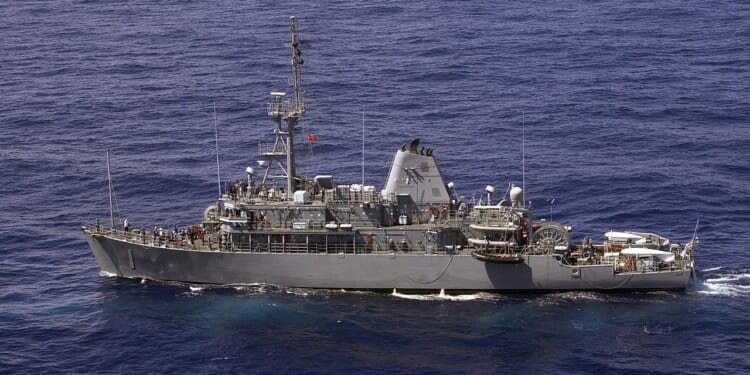The United States Navy announced on Thursday that it has decommissioned one of its remaining Avenger-class mine countermeasure ships, after the vessel had served for nearly four decades, operating worldwide, including in the waters of the Middle East. The recently decommissioned USS Sentry (MCM-3), USS Dextrous (MCM-13), USS Gladiator (MCM-11), and their respective crews were recognized in a ceremony in Manama, Bahrain, for their service on USS Devastator (MCM-6).
The four warships have been forward-deployed to the Middle East, as part of the US 5th Fleet’s Task Force 55/ Destroyer Squadron (DESRON) 50.
“For more than three decades, USS Devastator, USS Dextrous, USS Gladiator and USS Sentry have been critical to maritime missions around the globe—defending the freedom of navigation, promoting stability and deterring and defeating efforts by adversaries to harm the innocent,” said U.S. Navy Vice Adm. George Wikoff, commander, US Naval Forces Central Command (NAVCENT) and US 5th Fleet (C5F).
“To all, past and present, who have served on [these ships], thank you for standing the watch, being true trailblazers in the fleet and maintaining a constant presence in our area of operations… what a proud legacy you leave in your wake,” Wikoff added.
The US Navy Is Sweeping Its Minesweepers Away
A total of 14 Avenger-class mine countermeasure ships were constructed by Peterson Shipbuilders and Marinette Marine from 1987 to 1994. According to the US Navy, the MCMs were developed to serve as “mine sweepers/hunter-killers,” which could search for, classify, and destroy “moored and bottom mines.” In addition to being able to carry out conventional mine sweeping, each of the MCMs was outfitted with a variety of sonar and video systems to detect sea mines, as well as cable cutters and mine-detonating devices, including platforms that could be released and detonated remotely.
Three of the four oldest MCMs were previously retired from service between 2014 and 2020, while USS Guardian (MCM-5) ran aground on the Tubbataha Reef in the Sulu Sea and was subsequently scrapped. With the decommissioning of the Bahrain-based vessels, just four remain in service, homeported at Sasebo, Japan.
Why Minesweeper Ships Are Built of Wood
A noteworthy fact about the Avenger-class is that the hulls are constructed of wood, including oak, Douglas fir, and Nootka Cypress, and sheathed with fiberglass.
The choice of wood for a ship in regular exposure to naval mines is a curious one at first blush, but the logic behind it is sound. The mixtures of wood are meant to provide flexibility and strength, allowing the vessels to withstand a blast from a nearby mine. Metal is stronger than wood—but naval mines are often sensitive to metal, and designed to explode when they detect it, typically through magnetism. A wooden hull has little magnetic signature, and therefore avoids this problem.
The use of materials was noted during the recent decommissioning ceremony in comments made by Lt. Commander Alex Turner, commanding officer of the USS Devastator.
“As you carry the plank you own of Douglas fir away with you today, remember that with it you carry the legacy of the thousands of Sailors who come before you,” Turner explained, adding, “Today, Devastators’ watch has ended; her service is complete, but her legacy will endure… and in every Iron Man who is honored to call this wooden ship home, there are truly no greater heroes.”
America’s Littoral Combat Ships Are Getting a New Mission
As the MCMs are retired, the US Navy’s littoral combat ships (LCS) will be deployed to Bahrain. The problem-plagued vessels may have been designed for this specific role, but are being adapted accordingly.
Some of the Independence-class variants now in service are being outfitted with a Mine Countermeasure Mission Package (MCM MP), a suite of unmanned maritime sensors that were developed to locate, identify, and destroy mines in littoral waters.
The MCM package comprises an integrated suite of unmanned maritime systems and sensors, enabling the location, identification, and destruction of mines in the littoral areas while increasing the ship’s standoff distance from the threat area.
It remains unclear whether the MCM MP will be employed on the Freedom-class variants, but the US Navy has sought to find a role for the LCS, and mine countermeasures may be it.
About the Author: Peter Suciu
Peter Suciu has contributed over 3,200 published pieces to more than four dozen magazines and websites over a 30-year career in journalism. He regularly writes about military hardware, firearms history, cybersecurity, politics, and international affairs. Peter is also a contributing writer for Forbes and Clearance Jobs. He is based in Michigan. You can follow him on Twitter: @PeterSuciu. You can email the author: [email protected].
Image: Wikimedia Commons.


















